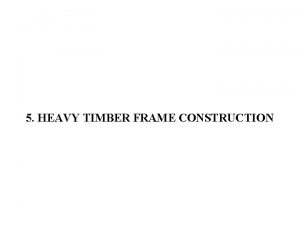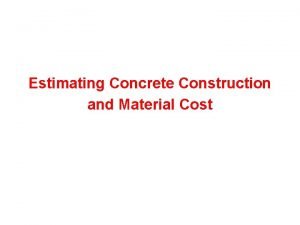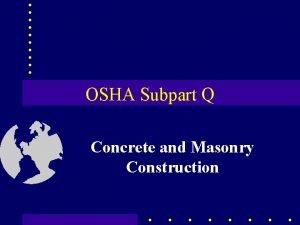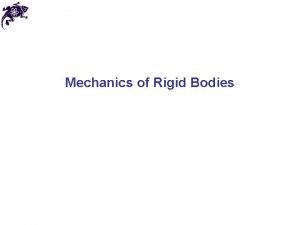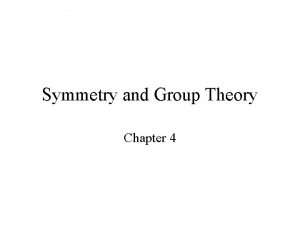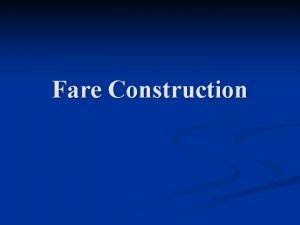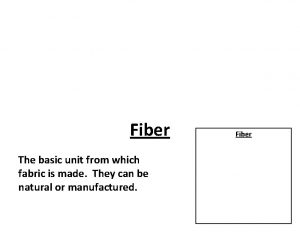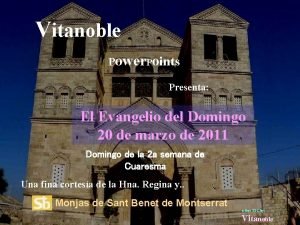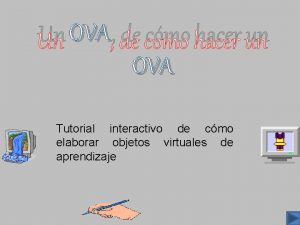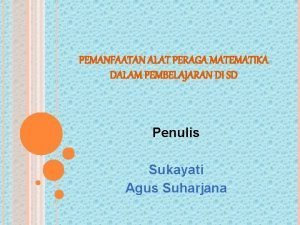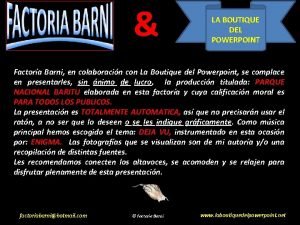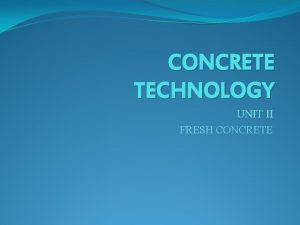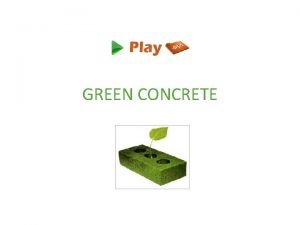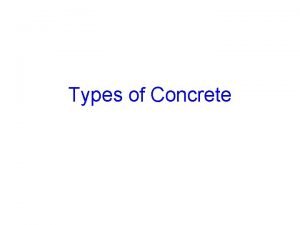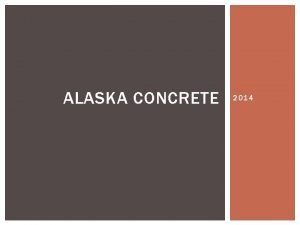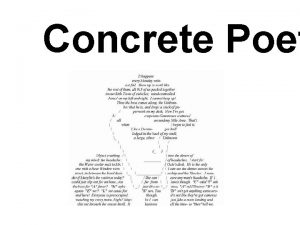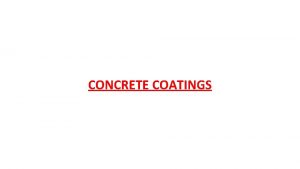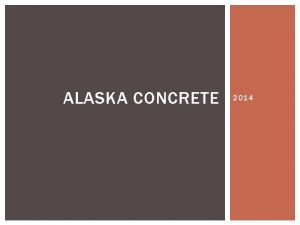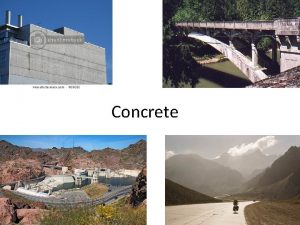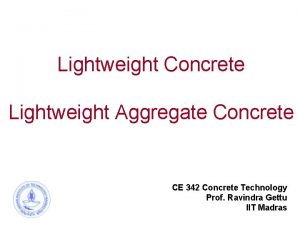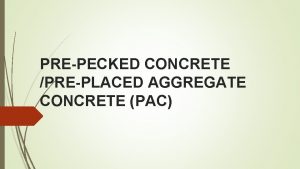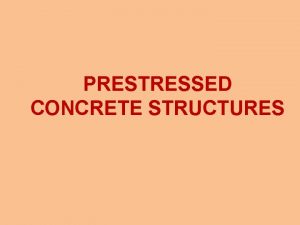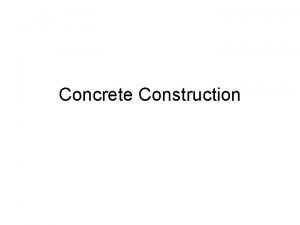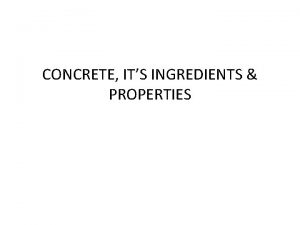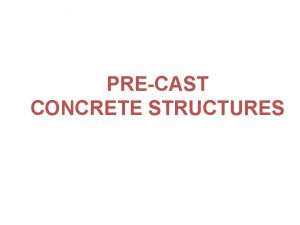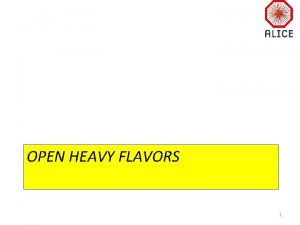Power Point Presentation Unit 68 Heavy Concrete Construction











































- Slides: 43

Power. Point® Presentation Unit 68 Heavy Concrete Construction Formwork Plywood Forms • Foundation and Basement Forms • Patented Ties and Waler Systems • Pilaster, Column, and Beam Forms • Floor and Roof Forms • Formwork Construction • Stairway Forms • Prefabricated Panel Forming Systems

Unit 68 — Heavy Concrete Construction Formwork An advantage of plywood in form construction is that it can be bent when a curved surface is required.

Unit 68 — Heavy Concrete Construction Formwork A release agent is sprayed on panels to be used for concrete forms to facilitate form removal. Follow manufacturer instructions for the safe use and application of form-release agents.

Unit 68 — Heavy Concrete Construction Formwork Outside form walls are erected and rebar is placed prior to constructing inside form walls.

Unit 68 — Heavy Concrete Construction Formwork Wood braces are equipped with turnbuckles at their lower ends to allow wall panels to be aligned. Turnbuckles are fastened to the ground with steel stakes. A brace plate is used to attach a brace to a waler or stiffback.

Unit 68 — Heavy Concrete Construction Formwork All‑steel wall braces may be used to support wall forms. Braces should be properly positioned to provide adequate support.

Unit 68 — Heavy Concrete Construction Formwork Metal window frames are secured to outside form walls as the walls are erected. The frames remain in place after the form walls are removed.

Unit 68 — Heavy Concrete Construction Formwork Door and window bucks use similar construction techniques. Door bucks do not require a bottom piece with an inspection pocket.

Unit 68 — Heavy Concrete Construction Formwork Rebar is placed after the outside form walls are set and before the inside form walls are erected.

Unit 68 — Heavy Concrete Construction Formwork Bulkheads may be required in long walls. Bulkheads are made of 1 × 8 s or 2 × 4 s which are notched around the rebar.

Unit 68 — Heavy Concrete Construction Formwork Form walls are doubled up after the rebar, door and window frames, and utilities have been properly located.

Unit 68 — Heavy Concrete Construction Formwork Snap ties are used to secure and properly space opposing form walls.

Unit 68 — Heavy Concrete Construction Formwork Internal disconnecting ties are commonly used on heavy walls.

Unit 68 — Heavy Concrete Construction Formwork Heavy construction panel forming methods commonly use 2 × 4 studs, which are reinforced by walers. Note the snap tie wedges along the walers.

Unit 68 — Heavy Concrete Construction Formwork Studs are not required for some single‑waler systems supported by strongbacks.

Unit 68 — Heavy Concrete Construction Formwork Pilasters provide additional strength to a wall and support the ends of beams. After the wall forms are positioned, walers and studs will be placed.

Unit 68 — Heavy Concrete Construction Formwork When assembling and placing wood column forms, tight joints and strong tie supports around the form are necessary. A cleanout hole is provided at the bottom of one of the sides.

Unit 68 — Heavy Concrete Construction Formwork Scissor clamps are tightened and held in place by cam devices or wedges driven into slots in the clamp.

Unit 68 — Heavy Concrete Construction Formwork Tubular fiber forms for round columns have been set in place and braced. Rebar will be set inside the tubes, and then concrete will be placed.

Unit 68 — Heavy Concrete Construction Formwork Column spring forms are stripped by removing the flange bolts and pulling apart the flanges.

Unit 68 — Heavy Concrete Construction Formwork A structural frame for a concrete building may include columns, beams, and girders.

Unit 68 — Heavy Concrete Construction Formwork Columns, girders, and beams may be formed as a single (monolithic) unit. Note that the beam and girder join over the column.

Unit 68 — Heavy Concrete Construction Formwork Concrete is placed at the same time for the walls, columns, beams, and girders of a monolithic unit.

Unit 68 — Heavy Concrete Construction Formwork This concrete floor system features a slab resting on concrete joists that tie into girders.

Unit 68 — Heavy Concrete Construction Formwork A flat‑slab floor may be supported by drop panels over the columns.

Unit 68 — Heavy Concrete Construction Formwork A flat‑slab floor may be supported by drop panels and capitals over the columns.

Unit 68 — Heavy Concrete Construction Formwork Long pans used for one‑way joist systems rest on 2″ thick soffits supported by shores and stringers.

Unit 68 — Heavy Concrete Construction Formwork Fiberglass dome forms are in place for a two-way joist system. Here, the worker is applying compressed air between the concrete slab and dome forms to loosen them.

Unit 68 — Heavy Concrete Construction Formwork Tubular shores and metal beams are commonly used with heavy construction formwork.

Unit 68 — Heavy Concrete Construction Formwork Metal scaffold shoring is used to support high form soffits.

Unit 68 — Heavy Concrete Construction Formwork Engineered wood products, such as laminated veneer lumber (LVL) beams and wood I-joists, provide proper support form soffits.

Unit 68 — Heavy Concrete Construction Formwork Slab decks may be supported by wood shores and stringers. Wedges placed under the shores or screw jacks attached to the shores provide for vertical adjustment.

Unit 68 — Heavy Concrete Construction Formwork Rebar is placed over the deck of the floor form. Note the opening for the beam extending the length of the deck.

Unit 68 — Heavy Concrete Construction Formwork When constructing first‑floor heavy construction forms over foundation footings, wall forms are first placed, followed by column, beam, and deck formwork. Note reinforcing steel is not shown.

Unit 68 — Heavy Concrete Construction Formwork Rebar for columns usually extends past the floor and beams that are supported by the columns. Rebar extending from this column will be tied to additional steel placed inside the form for the column of the floor above.

Unit 68 — Heavy Concrete Construction Formwork An outside wall panel is fastened to a previously placed floor using anchor bolts which are embedded in the floor slab.

Unit 68 — Heavy Concrete Construction Formwork Rebar extending from the floor level above and below is tied to rebar in the stairway.

Unit 68 — Heavy Concrete Construction Formwork A closed concrete stairway is built between two walls.

Unit 68 — Heavy Concrete Construction Formwork Prefabricated gang forms commonly include walers, strongbacks, lifting brackets, and scaffold brackets. Note the toprails, midrails, and toeboards in place to protect workers against falls and prevent materials from falling from the platforms.

Unit 68 — Heavy Concrete Construction Formwork The support for a flying floor form unit is provided by aluminum trusses placed on either side and aluminum beams placed across the trusses. A plywood deck is fastened on top of the beams. Adjustable jacks are used to raise the unit into position.

Unit 68 — Heavy Concrete Construction Formwork Flying forms used for floors or other structural members are set into place by crane.

Unit 68 — Heavy Concrete Construction Formwork Slip forms are commonly used in the construction of tall buildings. Concrete is transported to the upper level of the building and is placed in forms using a pumping apparatus.

Unit 68 — Heavy Concrete Construction Formwork The basic design of a standard slip form includes jackrods, hydraulic jacks, cross beams, and yoke legs. Additional features, such as scaffold, are custom made for the structure being erected.
 Shratey
Shratey Heavy timber
Heavy timber Informal inventory
Informal inventory Concrete semi concrete abstract
Concrete semi concrete abstract Topics for powerpoint presentation for class 4
Topics for powerpoint presentation for class 4 Power point presentation design west vancouver
Power point presentation design west vancouver Real power and reactive power
Real power and reactive power Power bi training powerpoint
Power bi training powerpoint 1 cubic yard of concrete weight
1 cubic yard of concrete weight During masonry construction the limited access zone must be
During masonry construction the limited access zone must be Point point power
Point point power What is rigid body
What is rigid body Unit 6 review questions
Unit 6 review questions Presentation construction
Presentation construction Hcl symmetry elements
Hcl symmetry elements Fare construction point adalah
Fare construction point adalah Diameters of fetal head
Diameters of fetal head Fundal height transverse lie
Fundal height transverse lie What are the
What are the Power tool safety powerpoint presentation
Power tool safety powerpoint presentation Point of view presentation
Point of view presentation The starting point in a presentation
The starting point in a presentation Solar power satellites and microwave power transmission
Solar power satellites and microwave power transmission Actual power and potential power
Actual power and potential power Flex power power supply
Flex power power supply Plane transmission grating is
Plane transmission grating is Power of a power property
Power of a power property General power rule
General power rule Power angle curve in power system stability
Power angle curve in power system stability Power absorbed or supplied
Power absorbed or supplied Evangelio del domingo en power point
Evangelio del domingo en power point Aplausos sonido
Aplausos sonido La boutique del powerpoint rincones del mundo
La boutique del powerpoint rincones del mundo Il mio sport preferito in francese
Il mio sport preferito in francese Power point turing complete
Power point turing complete Powerpoint sul riciclo
Powerpoint sul riciclo Fungsi blok dienes
Fungsi blok dienes Powerpoint sekolah sabat
Powerpoint sekolah sabat Laboutiquedelpowerpoint x
Laboutiquedelpowerpoint x La boutique del power point
La boutique del power point La boutique del power point
La boutique del power point La boutique del power point
La boutique del power point Pengertian gizi kuliner
Pengertian gizi kuliner Decreto 1330 de 2019 power point
Decreto 1330 de 2019 power point

